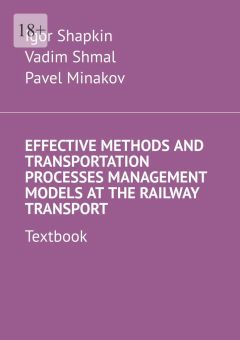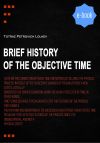Текст книги "Effective Methods and Transportation Processes Management Models at the Railway Transport. Textbook"

Автор книги: Igor Shapkin
Жанр: Прочая образовательная литература, Наука и Образование
Возрастные ограничения: +18
сообщить о неприемлемом содержимом
Текущая страница: 11 (всего у книги 11 страниц)
9.3 Creation of terminal complexes functioning economic and mathematical models
The high cost and cost of the process of creating new terminal complexes to ensure the effective functioning of transport corridors predetermine a careful analysis of the economic characteristics of the proposed solutions at the initial stages. It is possible to avoid significant costs due to incorrectly chosen approaches only through the expanded construction of an economic and technical justification, which is possible on the basis of the construction of economic and mathematical models proposed for the construction of terminal complexes. This paragraph proposes considerations designed to provide a reasonable approach to building similar models in real-world conditions for specific projects.
Usually, the need for the most accurate correspondence of the obtained models to what will be observed in reality is emphasized. In the author’s opinion, it is necessary to take into account the opposite position, i.e. the position of the victim. not to complicate the proposed models to the extent that it is not only impossible to understand the driving forces affecting the results obtained in the simulation models, but also it is not possible to improve the resulting models taking into account new realities, due to excessive complexity and separation from the original principles of building models.
At this stage, econometrics and, more broadly, general statistics offer a significant set of methods for analyzing a wide range of problems that arise when considering the economic aspects of enterprises, regions and entire countries. In a specific application to transport logistics, in addition, queuing theories and various technical disciplines play a significant role, tied to facilitate both a visual representation of emerging problems in process modeling and in the modeling process itself. Unfortunately, the very variety of available methods leads to the temptation of a thoughtless approach to creating models, when a specific method is used not because its application in a particular situation is justified, but because of the preferences of a particular researcher.
It is important that the choice of a particular modelling engine be based from the outset on well-founded basic principles. So, for example, many technical ones completely ignore economic components or use only primitive methods, which consist in calculating costs according to accounting. Although it is justified for certain purposes, its expanded use for feasibility studies seems to be flawed. Economic modeling, designed to calculate the expected profitability and answer the final question of the feasibility of investing in a project, must explicitly answer the forecast questions for the services provided by the constructed facilities, and therefore cannot be limited only to the supply side (i.e., the supply side of the project). calculation of costs alone). Often, profitability calculations implicitly imply simplified forms of such forecasting, such as extrapolation of observed trends in the markets in past periods, if not a simple replication of last year’s results. It seems reasonable to make such proposals and model constructions (however primitive they may be) explicit and to provide a reasonable discussion of the adequacy of the assumptions made in justification.
Note that information flaws often do not leave much choice in modeling, and the primitive approaches to demand modeling described above are all that is possible in this situation with a reasonable approach. The author does not offer a meaningless search for solutions to supposedly unsolvable problems, but only an awareness and justification of reasonably accepted restrictions on the modeling process. In such a situation, when changing the information component (collecting statistics, storing data in a more complete volume in newly developed information systems, etc.). It will not be difficult to extend the developed model by incorporating a more complex model of demand for services that is possible within the framework of an expanded set of data collected.
The need for careful consideration of the explicit (and implicit) assumptions made in the simulation seems reasonable within the framework of this study as a whole, and not only in the calculation of purely economic values.
For this problem, in turn, it is proposed to approximate them by piecewise linear functions, with an estimate (based on real data) of the values of distribution functions at nodal points.
This approach seems reasonable; However, many questions remain unanswered. They are especially important if such a technique is used in the framework of building an economic and mathematical model of a vast transport facility, such as a terminal complex within a functioning transport corridor. Indeed, statistics offers several possible approaches to estimating the distribution functions of unknown random variables, both parametric and nonparametric. The choice of a particular approach, of course, should be determined both by the quality of the available data and by the tasks of the analysis. Moreover, the very need to evaluate distribution functions may be too burdensome and unnecessary to achieve the objectives. So, the value of interest to the researcher is describing the discrepancy between the loading facilities and the volume of cargo. In order to calculate the final costs incurred as a result of delays in the delivery of goods, it is necessary to have a clear understanding of the penalties (both explicitly spelled out in the relevant contracts with shippers and consignees, and implicit, related to loss of reputation and the consequent effect on the demand for the services of the carrier). Of course, estimating individual distribution parameters instead of the entire distribution is less time-consuming and can be done with greater accuracy on the same set of statistics.
Thus, apparently, the minimum requirements for an adequate simulation model designed to help harmonize the formation plans and train schedules are highlighted, but specific mechanisms for finding the (optimal) functional dependencies required by the authors are not given. Thus, the cited work takes the first important step in this direction, but there is still considerable work to be done in the implementation of the proposed plans for building a model.
Mention should be made of the need to calculate the optimal management structure for the coordinated operation of various modes of transport in and around the terminal hub. As an example of such work, we can cite an article that describes the results of calculating the economic efficiency of several options for the decentralized organization of local work management on the port railway.
In the monograph, on the basis of modern system analysis, scientific and industrial experience, modern mathematical methods and algorithms for solving problems based on the basic technological principles of railway operation, the introduction of which ensures higher stability, reliability and safety of railway transport based on innovative technologies, original and economic criteria, are considered and presented.
The authors reflect in detail the history of the development of railways over a 180-year period, the state and prospects for the development of railway transport during the period of large-scale reforms, the implementation of new principles for managing the transportation process and increasing its efficiency.
The ways of creating a model of the future and the main directions of scientific research in the field of further improvement of the transportation process in railway transport on the basis of scientific and technical achievements and informatization, the ways of business development and customer focus of the Russian Railways Holding, the introduction of logistics management methods, information and digital technologies are formulated.
Scientific approaches to solving control problems based on mathematical methods and decision-making algorithms are considered in detail. For the effective management of a complex transport system, a hierarchical management structure is necessary.
Literature
1. Бакин, А. А. Исследование интенсивности подхода пассажиров на остановочные пункты пригородных электропоездов / А. А. Бакин, С. П. Вакуленко // Экономика железных дорог. – 2023. – №2. – С. 54—64. – EDN TAAWIO.
2. Докукина, А. А. Теоретические основы концепции экономической безопасности предприятия в контексте цифровой трансформации / А. А. Докукина // Экономика, предпринимательство и право. – 2023. – Т. 13, №4. – С. 1105—1124. – DOI 10.18334/epp.13.4.117490. – EDN GMPCUZ.
3. Методология и механизмы управления нематериальными ресурсами и активами в сфере электронной торговли на основе ценностно-ориентированной модели / С. В. Панасенко, О. С. Каращук, Е. А. Красильникова [и др.]. – 2-е издание. – Москва: Издательско-торговая корпорация «Дашков и К», 2024. – 284 с. – ISBN 978-5-394-05565-2. – EDN RZEABA.
4. Об актуальности развития диаметрального движения дневных экспрессов дальнего следования через московский железнодорожный узел / М. В. Роменская, М. В. Кулалаева, А. Д. Ершов, А. В. Екимов // Техника и технология транспорта. – 2023. – №1 (28). – EDN XBQGCF.
5. Об актуальности развития диаметрального движения дневных экспрессов дальнего следования через московский железнодорожный узел / М. В. Роменская, М. В. Кулалаева, А. Д. Ершов, А. В. Екимов // Техника и технология транспорта. – 2023. – №1 (28). – EDN XBQGCF.
6. Опыт и перспективы автоматизации управления перевозочным процессом скоростного транспорта городских агломераций / В. Г. Сидоренко, Е. В. Копылова, А. И. Сафронов, М. А. Туманов // Автоматика на транспорте. – 2023. – Т. 9, №1. – С. 33—48. – DOI 10.20295/2412-9186-2023-9-01-33-48. – EDN ZIYEID.
7. Создание автоматизированной программы по расчету значений целевых показателей для выполнения графика движения / В. И. Ульяницкая, Е. М. Иванова, Д. Ю. Исакова, А. М. Кишикова // Известия Петербургского университета путей сообщения. – 2023. – Т. 20, №1. – С. 172—181. – DOI 10.20295/1815—588X-2023-1-172-181. – EDN IRZGKE.
8. Судаков, В. А. Методы машинного обучения при расчёте скоринга клиентов банка / В. А. Судаков, Т. П. Семенов // Международный журнал информационных технологий и энергоэффективности. – 2023. – Т. 8, №3 (29). – С. 22—25. – EDN RCIRND.
9. Тимкова, А. Ю. Имитационное моделирование динамического изменения пассажиропотока в метрополитене / А. Ю. Тимкова // Вестник транспорта Поволжья. – 2023. – №1 (97). – С. 76—80.
10. Шишкина, М. А. Постпозитивистская философия Карла Поппера / М. А. Шишкина // Человек. Культура. Общество: Материалы XIII Международной научно-практической конференции, Пенза, 19—20 апреля 2023 года / Под редакцией Н. В. Розенберг. – Пенза: Пензенский государственный университет, 2023. – С. 133—137. – EDN NQABKX.
11. Шорохова, Л. С. Методические основы организации туристических маршрутов с использованием железнодорожного транспорта / Л. С. Шорохова // Транспортное дело России. – 2023. – №2. – С. 113—116. – DOI 10.52375/20728689_2023_2_113. – EDN QTSODE.
Правообладателям!
Это произведение, предположительно, находится в статусе 'public domain'. Если это не так и размещение материала нарушает чьи-либо права, то сообщите нам об этом.








































